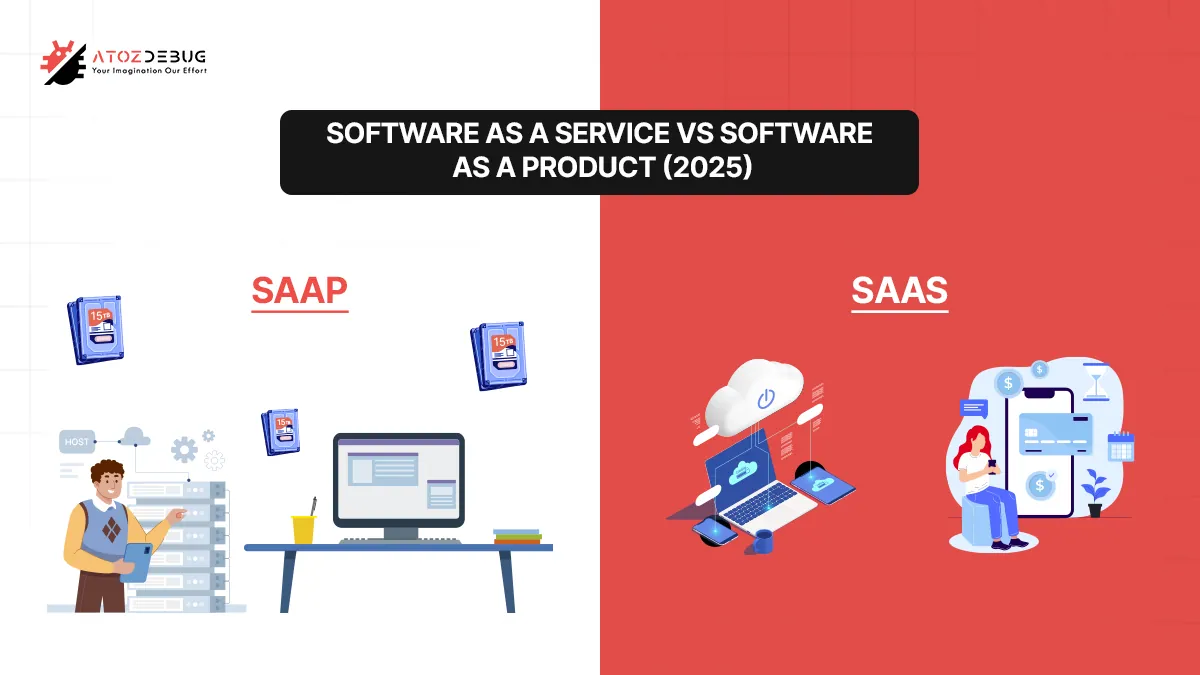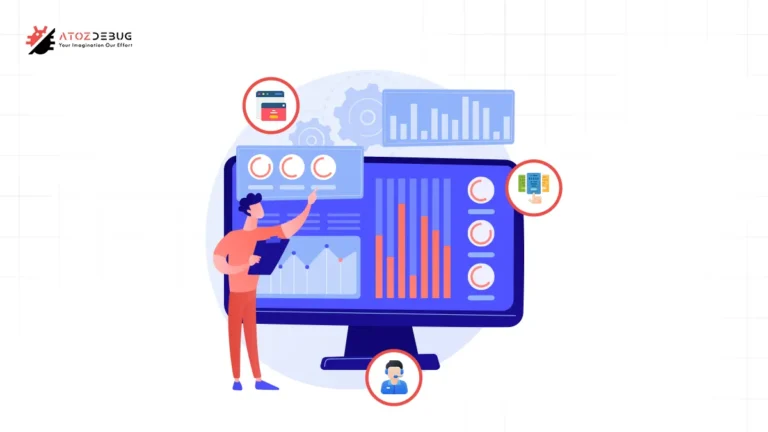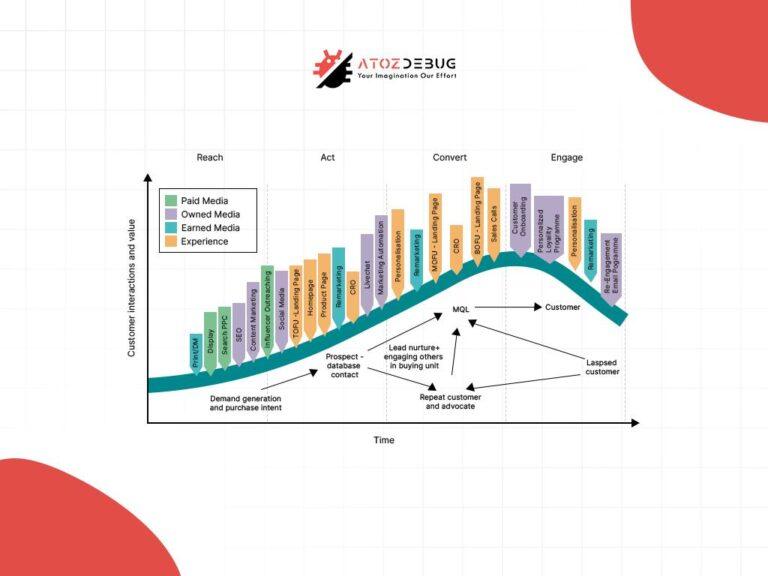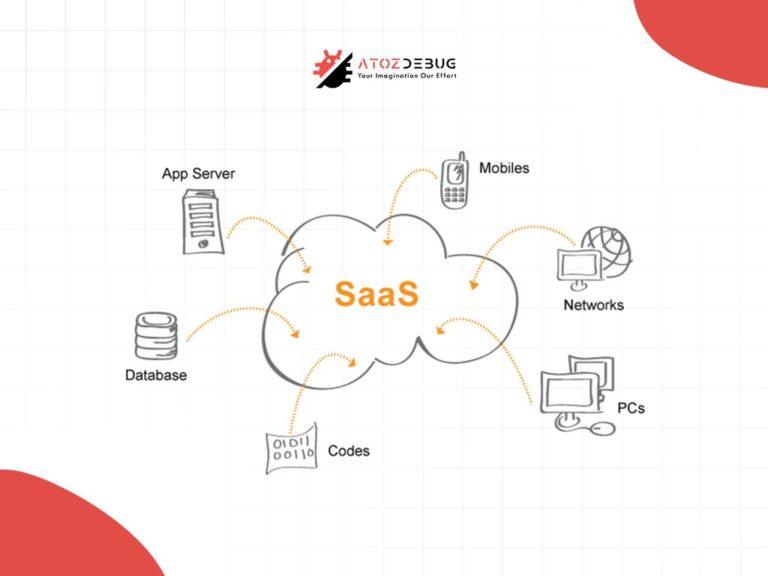In 2025, choosing between Software as a Service (SaaS) and Software as a Product (SaaP) has become a crucial decision for businesses of all sizes.
SaaP follows the traditional model, wherein a business runs the software on its own systems by purchasing a one-time license. SaaS, on the other hand, is subscription-based, hosted on the cloud and managed by the provider.
Both approaches offer clear benefits.
SaaS is known for its low initial cost, scalability, and automatic updates, making it attractive to growing companies.
SaaP offers full control, offline access, and strong data ownership, which is still valuable in industries with strict compliance requirements.
The shift from SaaP to SaaS over the past decade has been dramatic, yet there are still areas where on-premise software holds its ground.
Understanding the differences in cost, flexibility, security, and long-term value is essential to making the right choice.
This comparison explains how each model will work in 2025, where they fit best, and what factors businesses should consider before making a decision.
What is Software as a Product (SaaP)?
Software as a Product (SaaP) is a traditional model where you purchase a license and manage the software on your own systems.
It usually involves a high upfront cost but avoids recurring monthly fees. However, maintenance, updates, and upgrades can add extra expenses. SaaP often works offline or within a private network, which makes it reliable even without constant internet.
Updates are not mandatory, but they’re recommended for new features and compatibility. While once popular, many giant companies, like Microsoft and Adobe, have shifted from SaaP to SaaS, which makes traditional versions harder to find these days.
What is Software as a Service (SaaS)?
Software as a Service (SaaS) is a cloud-based model where applications are delivered over the internet and managed entirely by the provider. Users access SaaS through web apps without worrying about installation, maintenance, or infrastructure.
Unlike traditional software, SaaS usually runs on shared resources (multi-tenant systems). But it can offer dedicated setups for extra cost. SaaS provides continuous updates, scalability, and flexibility at lower costs thanks to economies of scale.
SaaS is mostly subscription-based, though freemium and usage-based models also exist. This makes it the most common software delivery approach today.
How Has Software Evolved from SaaP to SaaS
The shift from SaaP to SaaS happened gradually. For decades, software was distributed on media (CDs, downloads) and sold as a product. That model favoured one-time revenue and local control. But, in the last 10-15 years, companies and users began to prefer subscription access, continuous updates, collaboration features, and lower upfront costs.
Leading companies like Microsoft, repackaged with Office 365, and Adobe, with Creative Cloud, set the trend. Their move showed the industry’s clear shift toward SaaS and recurring revenue.
Also read: Mastering SaaS Problem Statements
What Are the Key Differences Between SaaS and SaaP?
| Category | SaaS (Software as a Service) | SaaP (Software as a Product) |
|---|---|---|
| Upfront Cost | Lower, subscription-based | High, one-time purchase + infrastructure |
| Scalability | Easy to scale (users, storage, features) | Harder to scale, needs extra hardware/licenses |
| Updates | Automatic updates & security by provider | Manual updates, risk of falling behind |
| Accessibility | Works on any device with internet, good for teamwork | Works offline, good for secure/remote locations |
| IT Work | Less IT work, provider manages servers & backups | More IT responsibility (security, backup, compliance) |
| Customization | Limited, provider-controlled | Full control over data, updates, and integrations |
| Costs Over Time | Ongoing subscription fees, may get costly long-term | One-time license, stable costs unless upgrading |
| Data Handling | Data stored by vendor, sometimes location restrictions | Data stays in-house, fits strict governance policies |
| Vendor Lock-in | Risk of being tied to one provider | No vendor lock-in, full ownership |
SaaS Benefits:
- Lower upfront cost: You don’t need to spend a large amount at once. With monthly or yearly subscriptions, costs are spread out and easier to manage.
- Easy to scale: Adding more users, storage, or features is quick and doesn’t need extra hardware or licenses.
- Automatic updates and security: The provider takes care of updates, bug fixes, and security for all customers.
- Quick setup and teamwork: You can use SaaS on any device with internet access, making remote work and real-time collaboration smooth.
- Less IT work: Your team doesn’t need to handle servers, backups, or system maintenance, so they can focus on other important tasks.
SaaS Drawbacks:
- Needs internet: A strong connection is required for access.
- Limited customization: You can only make changes allowed by the provider, not deep system modifications.
- Risk of vendor lock-in: Moving your data and settings to another provider can be difficult and costly.
- Ongoing subscription fees: While cheaper at the start, long-term costs can be higher depending on usage.
- Data location issues: Some vendors don’t let you choose where your data is stored, which can affect compliance in certain industries.
SaaP Benefits:
- Full control: You decide where data is stored, when updates happen, and how the system connects with other tools.
- Works offline: SaaP doesn’t depend on internet, making it useful for remote locations or secure setups.
- One-time purchase: Once you buy the license, you can usually use it forever without paying again.
- Stable features: The software won’t change unless you choose to upgrade, avoiding surprise updates.
- Data stays in-house: Information remains inside your own systems, which is good for strict governance policies.
SaaP Drawbacks:
- High upfront cost: Purchasing licenses, servers, and supporting infrastructure requires a big capital expenditure.
- Harder to scale: Adding new users or capacity requires hardware procurement, configuration, and sometimes additional licenses.
- Manual updates: You generally have to install patches and upgrades yourself, which can interrupt work.
- Slower Improvements: Businesses may fall behind on features and improvements if they delay upgrades.
- More IT responsibility: Security, backup, disaster recovery, and compliance are all the organization’s responsibility.
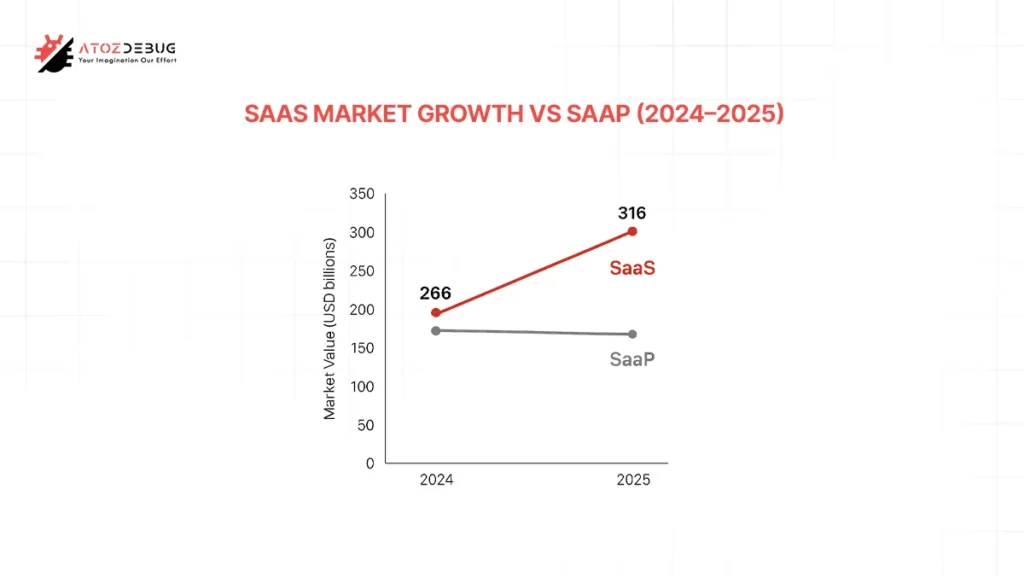
Which Model Is Growing Faster: SaaS or SaaP? (Market Trends & Statistics)
SaaS has been one of the biggest success stories in recent years. It is by far the fastest-growing software model. Recently, market research shows that the global SaaS market is already worth hundreds of billions of dollars and is still increasing fast.
As per the data, SaaS is valued at about USD 266 billion in 2024 and is expected to reach around USD 316 billion in 2025, with predictions of even bigger growth over the next decade.
Other reports have also given similar multi-billion-dollar estimates for the mid-2020s, which shows that spending on cloud software is consistently rising.
At the same time, public cloud spending overall (SaaP/IaaS/SaaS combined) is forecast to grow strongly in 2025. It is driving vendor investment in SaaS capabilities and platform services.
Architecture & Scalability
SaaS products usually run on a multi-tenant cloud infrastructure where many customers use the same platform and code. This architecture makes it easy to centralize updates, use resources efficiently, and scale quickly. To speed up deployment and standardize operations, many SaaS vendors also use PaaS tools.
On the other hand, SaaP tends to be one-off or single-tenant installs for each customer. It allows more customization but also needs extra work, like capacity planning, load balancing, and manual updates. For tasks needing strict speed, local data, or special hardware, SaaP or private clouds can still be the better choice.
Monetization & Business Models
Software as a Product (SaaP)
In the past, software was usually sold through a one-time license. Customers paid upfront to buy the product, and sometimes they could pay extra for maintenance or upgrades.
This gave companies a big payment at the beginning but no steady income afterward. They had to wait until the next version or release to earn again. As a result, revenue was often unpredictable because it depended on large purchases happening at the right time, rather than a regular stream of income like today’s subscription models provide.
Software as a Service (SaaS):
With SaaS, pricing usually works on subscriptions, either monthly or yearly. Other models include freemium plans with paid upgrades, usage-based billing (like paying per user, per API call, or per storage used), or a mix of these options.
Because customers pay regularly, SaaS companies have a steady flow of income. This also pushes vendors to keep improving the product since renewals depend on customer satisfaction. Growth often comes from upselling new features, adding more users, or expanding services.
What’s the Strategic Alignment?
The way SaaS products are priced directly affects how they are designed. This is why we see things like usage-based plans, feature limits, or extra add-ons.
When companies set their pricing in a way that matches the value customers get, for example, charging based on actual usage for workloads that are heavy but occasional, it helps customers adopt the product faster and gives the company steady, predictable income.
A good example is Adobe, which shifted to a subscription model to earn consistent revenue.
Which Is More Secure: SaaS or SaaP?
SaaS and SaaP both handle security differently, and each has trade-offs.
– With SaaS, the vendor manages updates, patches, and compliance. This reduces the workload for businesses, but security depends on the provider.
Since SaaS runs on shared infrastructure, a single issue can impact many users. You also have less direct control over data storage and access.
– With SaaP, the software runs on local servers, giving the business full control over security measures. This can be useful for industries with strict rules.
However, it also means the company is responsible for patches, firewalls, and backups. If updates are delayed, systems may be left vulnerable.
– The subscription model also brings risks. If a vendor fails, discontinues a service, or if a subscription lapses, access to software and stored data could be lost.
Simply put, SaaS makes security easier but requires strong trust in the provider. SaaP offers control but demands more responsibility.
Where Is SaaP Still Relevant Today?
In 2025, Software as a Product is still useful in certain areas where full local control or strict rules are important. Some examples are:
- Industrial systems: Machines and SCADA setups in factories often need software installed directly on-site.
- Finance and government: Banks and agencies prefer local software to follow strict data laws and keep full control.
- Offline security tools: Air-gapped networks still need antivirus and scanning tools that run without the cloud.
- Custom enterprise setups: Old or heavily customized systems are often too costly to move to the cloud.
- Healthcare equipment: Hospitals rely on on-device software for diagnostic tools and medical machines.
In short, many organizations currently mix these with hybrid models. This keeps critical parts on-site while using the cloud for collaboration and analytics.
Is Hybrid SaaS the Best of Both?
Hybrid SaaS models mix on-premise control with flexibility.
For example, a company might keep core records on local systems but use the cloud for analytics. Or they may run vendor-managed services on local hardware (like AWS Outposts or Azure Stack) to handle speed, compliance, or data laws.
This setup allows businesses to keep sensitive tasks in secure environments while still using cloud benefits such as automatic updates and AI tools.
In 2025, hybrid options are common for enterprise customers who need both control and modern SaaS features. But hybrid systems can be harder to manage and need extra oversight, so they are best only when there’s a real need, not as the default choice.
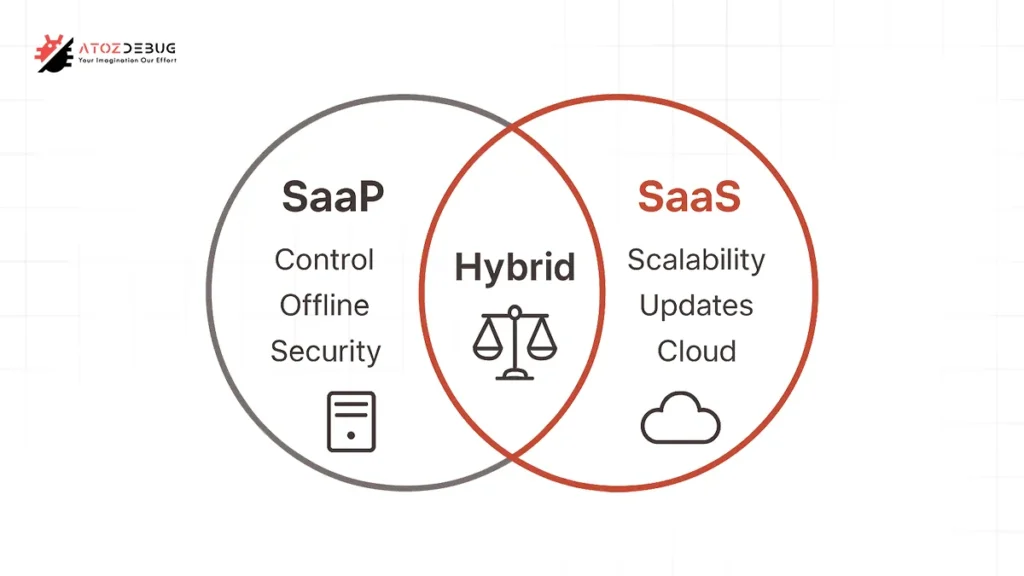
How Can You Choose the Right Model for Your Business?
You can choose the right model for your business by considering these:
- Data sensitivity & compliance: If regulation demands on-prem data or auditability, favour SaaP or hybrid.
- Operational maturity: Do you have the people and processes to patch, monitor, and back up software reliably? If not, SaaS reduces operational risk.
- Scale & variability: If user numbers will spike or shrink frequently, SaaS elasticity lowers cost and risk.
- Customization needs: Deep, code-level customisation usually favours SaaP or a private/hybrid SaaS.
- Total cost of ownership (TCO): Compare hardware + licence + staffing (SaaP) versus subscription + integration + possible overage (SaaS) across a realistic multi-year horizon.
- Exit strategy: Check data portability, APIs, and contract terms. Avoid painful lock-in by demanding export mechanisms or building integration layers.
A Practical Approach: Create a short chart, scoring each requirement (security, latency, cost, speed, customization), and use it to pick SaaP, SaaS, or hybrid.
Conclusion
In 2025, SaaS has become the common choice for most businesses. It is easier to use, updates are faster, and cloud adoption continues to grow worldwide. This makes it the default model for many new software launches.
But SaaP is still relevant. Some businesses need full control, offline use, or heavy customization. In industries with strict rules, on-premise ownership is often the only option.
Hybrid models (mix of both) are also growing, giving companies the benefits of both worlds.
Overall, the key is to choose options that align with your goals and daily needs. Look at costs, security, compliance, and how easy it will be to move data in the future.
And, yes, do not just follow the trend. Use a clear strategy to guide your decision. When you consider all these things, it will help your business run better.
Frequently Asked Questions (FAQs)
Q1. Is SaaP still relevant in 2025?
Yes. SaaP is still relevant in 2025, especially for companies that need strict control over their data, offline operation, specialized hardware, or heavy customization.
Q2. Can companies use both SaaS and SaaP together (hybrid model)?
Yes. Many companies use a mix of both in a hybrid model. This way, they keep some control with on-premise systems (SaaP) while also enjoying the flexibility of the cloud (SaaS). This is common in industries with strict rules or where speed and low delay are very important.
Q3. Why are businesses shifting from software as a product to SaaS?
The reasons are quite simple. SaaS offers lower upfront costs, faster results, fixed and predictable costs, automatic updates for security and new features, and easy scaling.
Q4. What is the main difference between SaaS and SaaP?
SaaS is ready-to-use cloud software, which you can access over the internet on any compatible device. On the other hand, SaaP provides the tools and platform, so teams can build and run their own apps without worrying much.
Q5. Which is more cost-effective in the long run: SaaS or SaaP?
It depends. SaaS has regular, predictable costs, but over the years of use, it can become more expensive. SaaP needs a big upfront payment, but it avoids monthly fees, though you still have to spend on maintenance.
Q6. Is SaaS more popular than SaaP in 2025?
Yes. SaaS has become the dominant model in 2025 because it offers flexible subscriptions, automatic updates, and easier scalability. Most new software is now launched in a SaaS format.
Q7. What are some real-life examples of SaaS and SaaP?
SaaS Examples: Google Workspace, Salesforce, Canva, Slack.
SaaP Examples: AutoCAD, QuickBooks Desktop, older versions of Microsoft Office.
Q8. Which is better for small businesses: SaaS or SaaP?
For most small businesses, SaaS is more practical. It reduces upfront investment, requires less IT management, and can grow as the business expands. SaaP is more suitable for organizations that need strict control, offline use, or custom setups.
Q9. Q5. Which model is more cost-effective in the long run?
It depends on usage. SaaS spreads costs over time, but long-term subscriptions may exceed the one-time cost of SaaP. SaaP avoids monthly fees but requires ongoing spending on hardware, updates, and IT staff.
References
- Gartner. Worldwide Public Cloud End-User Spending Forecast to Total $723 Billion in 2025. CIO Dive. Available at: https://www.ciodive.com/news/cloud-spend-growth-forecast-2025-gartner/733401
- AscendixTech. How Many SaaS Companies Are There in 2024–2025? Ascendix Technologies. Available at: https://ascendixtech.com/number-saas-companies-statistics/
- Majic, J. (2024). The End of the SaaS Era: Rethinking Software’s Role in Business. Forbes. Available at: https://www.forbes.com/sites/josipamajic/2024/09/30/the-end-of-the-saas-era-rethinking-softwares-role-in-business/
- Wikipedia. Adobe Creative Cloud. Available at: https://en.wikipedia.org/wiki/Adobe_Creative_Cloud
- Microsoft. Looking Back at Ten Years of Microsoft 365. Microsoft Stories. Available at: https://www.microsoft.com/en-us/microsoft-365-life-hacks/stories/looking-back-ten-years-microsoft-365

